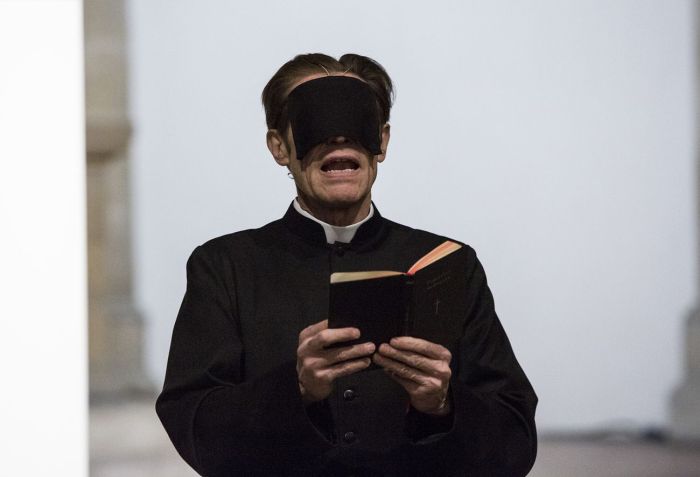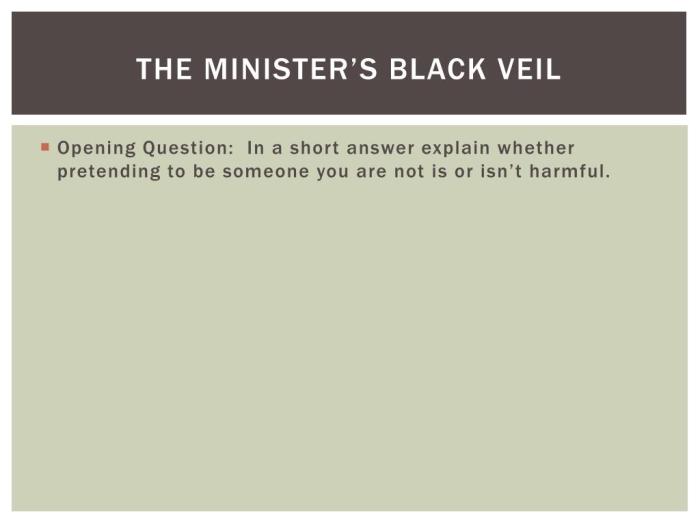Figurative language in the minister’s black veil – Figurative language in “The Minister’s Black Veil” is a literary device employed by Nathaniel Hawthorne to create a profound and multilayered narrative. It serves as a powerful tool that enhances the story’s atmosphere, character development, and overall meaning.
Through the skillful use of similes, metaphors, and personification, Hawthorne explores the complexities of human nature, the weight of secrets, and the enduring power of symbolism.
1. Introduction to Figurative Language

Figurative language is a literary device that uses words or phrases in a non-literal way to create a vivid image or convey a deeper meaning. It enhances the storytelling experience by engaging the reader’s imagination and emotions.
Figurative language is essential in literature because it allows authors to express complex ideas and emotions in a creative and engaging way. It also helps readers connect with the characters and events in a more profound manner.
2. Figurative Language in “The Minister’s Black Veil”
Similes
Similes are comparisons using the words “like” or “as” to create vivid images. In “The Minister’s Black Veil,” Hawthorne uses similes to describe the veil’s appearance and its impact on the community.
- “His figure had a strange, misty indistinctness—seemed to merge into the darkness, like the smoke of a burning coal.”
- “The black veil was a horrible thing on his face, but whether the strangeness of his aspect was owing to a natural deformity, or to some artificial contrivance, none could tell.”
Metaphors
Metaphors are comparisons that imply a deeper connection between two things. In “The Minister’s Black Veil,” Hawthorne uses metaphors to symbolize the veil’s significance and its effect on the minister.
- “The minister appeared like one who had been fighting with the world and had been worsted.”
- “The veil was like a black curtain, separating him from the world.”
Personification
Personification is giving human qualities to non-human things. In “The Minister’s Black Veil,” Hawthorne personifies the veil as a character with its own agency and purpose.
- “The veil was an alien thing, a monster, a devil, and seemed to be wriggling itself slowly around him.”
- “The veil was a mystery which none could penetrate, a symbol which made the minister the enigma of the community.”
3. Symbolism and Allegory
Symbolic Meaning of the Black Veil
The black veil is the central symbol in the story. It represents the minister’s hidden sin and his desire to isolate himself from the community.
- The veil is described as “a horrible thing,” suggesting the minister’s guilt and shame.
- The veil separates the minister from the world, symbolizing his alienation and isolation.
Allegorical Elements
“The Minister’s Black Veil” can be interpreted as an allegory, a story with a hidden moral or political meaning. The veil can be seen as a representation of sin and the consequences of hiding it.
- The veil is a constant reminder of the minister’s past actions, which he cannot escape.
- The community’s fear and rejection of the minister show the consequences of hiding one’s sins.
Foreshadowing
Hawthorne uses foreshadowing to hint at the veil’s significance and the minister’s ultimate fate.
- The minister’s decision to wear the veil is described as “a fearful thing.” This foreshadows the negative consequences that will follow.
- The minister’s appearance changes drastically after he puts on the veil, foreshadowing his isolation and eventual death.
4. Theme and Character Development
Main Themes
“The Minister’s Black Veil” explores several themes, including:
- The consequences of sin and the importance of forgiveness.
- The dangers of isolation and the importance of community.
- The power of symbolism and allegory in literature.
Character Development
Figurative language plays a crucial role in developing the minister’s character.
- The veil becomes a symbol of the minister’s inner turmoil and his struggle with his conscience.
- The community’s reaction to the veil shows the minister’s isolation and his inability to connect with others.
Irony
Hawthorne uses irony to highlight the minister’s hypocrisy and the community’s judgmental nature.
- The minister preaches about the importance of forgiveness, yet he cannot forgive himself for his past sins.
- The community condemns the minister for wearing the veil, yet they are just as guilty of sin and judgment.
5. Impact of Figurative Language on the Story’s Meaning: Figurative Language In The Minister’s Black Veil

Atmosphere and Mood
Figurative language creates a unique atmosphere and mood in “The Minister’s Black Veil.”
- The similes and metaphors create a sense of mystery and unease.
- The personification of the veil makes it a tangible threat, adding to the story’s suspense.
Reader’s Interpretation, Figurative language in the minister’s black veil
Figurative language influences the reader’s interpretation of the events in the story.
- The veil’s symbolism allows readers to draw their own conclusions about the minister’s sin and the community’s response.
- The allegory invites readers to consider the broader moral and political implications of the story.
Lasting Impact
The use of figurative language in “The Minister’s Black Veil” has had a lasting impact on the story’s legacy.
- The veil has become an iconic symbol of guilt and isolation in literature.
- The story’s allegory has been interpreted in various ways, making it a timeless and thought-provoking work.
FAQs
What is the significance of the black veil in the story?
The black veil symbolizes the hidden sins and secrets that Mr. Hooper carries within him. It becomes a physical manifestation of his inner turmoil and the burden of guilt that he bears.
How does figurative language contribute to character development in the story?
Figurative language helps to reveal the inner thoughts and emotions of the characters. It allows readers to gain insights into their motivations, fears, and desires, thereby enhancing the reader’s understanding of their character development.

